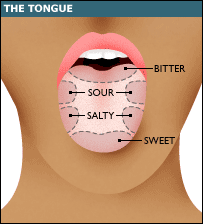
TASTE AND SMELL



Sense of Taste
David Lenin’s, Tour the Tongue, 2009, explained that the sensation of tasting begins with the taste papillae on the tongue, which contain the taste buds. These taste buds are located mainly on the sides, back and tip of the tongue. Each bud contains a variety of cells which are able to detect various chemicals and in effect all types of tastes. At the top of each cell there are microvilli which have receptors that sense each taste. When the chemicals come in contact with each receptor, the receptors send signals through the nervous system by means of cranial nerves to the brain (Institute for Quality and Efficiency in Health Care (IQWiG), 2012). Figure 1 below, by Pearson Education (2011) depicts the structure of the taste bud.
Figure 1. Structure of the taste bud.
Institute for Quality and Efficiency in Health Care (IQWiG), (2012) explains that “there is a long-held misconception that the tongue has specific zones for each flavor where you can taste sweet or sour, for example, especially well” (para. 15). Figure 2 below, retrieved from BBC news (2006) depicts this long-held misconception. All taste buds contain a variety of sensors which allow all tastes to be perceived on every part of the tongue. Figure 3 retrieved from Institute for Quality and Efficiency in Health Care (2012), depicts this fact, in which all parts of the tongue can perceive all tastes. The only areas of difference are that the sides of our tongue are more sensitive to taste than the middle, and that the back of our tongue is especially sensitive to bitter tastes in order to protect us from poisonous or spoilt foods before it reaches our throats (Institute for Quality and Efficiency in Health Care (IQWiG), 2012).

Figure 2. Various tastes are perceived on different parts of the tongue.
